Blotter-on-the-landscape
Steve Rouse must hate Pitchcare. The last time the Edgbaston Head Groundsman appeared in the pages of our magazine, some three years ago, he was interviewed by our editor, Laurence Gale. So heavy was the rain on the day of his visit that Steve joked (at least, we think it was a joke) that he "never wanted to see that bloody Laurence again - just keep him away!"
 So, we thought we'd try a different tack this time, and ask his agronomist consultant, David H Bates, to 'do a story' on his preparation for the third Ashes Test.
So, we thought we'd try a different tack this time, and ask his agronomist consultant, David H Bates, to 'do a story' on his preparation for the third Ashes Test.
Cue torrential rain. In the two days prior to the Test match there was hardly a break in the clouds. The preceding week had also been pretty wet, so Steve's usual wicket preparation was severely hampered.
On the eve of the game, a report from the ground, by one of the Sky TV commentators, whimsically called 'the state of play', showed excessive flooding on the outfield, with Steve and his team in the background busily trying to remove water, even as more fell. It was to be a thankless task, and one that, ultimately, failed to allow a scheduled start to the game on Thursday.
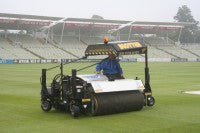 Steve, and a team of seventeen, had worked through the night and, as the 11.00am start time approached, with further showers scurrying across the ground, it became clear that much of the good work had been undone.
Steve, and a team of seventeen, had worked through the night and, as the 11.00am start time approached, with further showers scurrying across the ground, it became clear that much of the good work had been undone.
In front of the TV cameras Steve is very personable and confident, but there is only so much "we are doing all we can" that an impatient crowd will take. When the sun came out and 'further inspection' times ate into the day's play, the assembled Barmies, Mexicans, Elvis's et al, started booing. It was a natural, if somewhat unfair, reaction from a crowd who had parted with the best part of £100 to see a day's Ashes cricket and were, apparently, being denied by the over cautiousness of match officials.
Of course, they weren't to know how high the water table was - Steve described it as pouring water onto a soaking sponge - or how much rain had fallen the day before and overnight. They wanted to see cricket. And, as the sun stayed out and the mopping up continued, each umpires' inspection was greeted with ever louder boos.
 However, it was clear, from the umpires stabbing the turf with umbrellas and Sir Ian 'Beefy' Botham bringing up water when he pressed his foot into the grass, that certain sections of the outfield, and the bowlers run-ups, were simply not safe for cricket.
However, it was clear, from the umpires stabbing the turf with umbrellas and Sir Ian 'Beefy' Botham bringing up water when he pressed his foot into the grass, that certain sections of the outfield, and the bowlers run-ups, were simply not safe for cricket.
The wicket, under Edgabston's new hover cover and pull out sheets "would be fine" according to Steve.
Eventually, it was agreed that play would begin at 5.00pm with Beefy commentating "if it's fit at five then it was fit at three, I see no difference". He was clearly miffed, and stated that play probably should have been abandoned for the day, simply because the outfield was dangerous adding, somewhat cynically, that "ticket revenue seems to be the criteria for getting play underway".
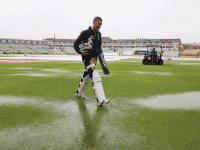

When play eventually began, England's bowlers were as damp as the outfield. Only thirty overs were possible and the Aussie batsmen rattled off over 100 runs for the loss of one wicket, before close.
The weather on day two was far better and spirited bowling by Anderson and Onions saw the Aussies skittled out for 263. In reply, the England top order set about some 'average' bowling from the tourists.
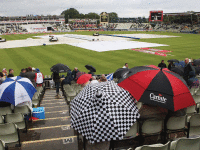 And then, late in the day, the rain returned. It didn't stop. It rained all night and throughout Saturday. Play was abandoned for the day and another 'overnighter' beckoned for Steve to clear the 'ponds' off the outfield.
And then, late in the day, the rain returned. It didn't stop. It rained all night and throughout Saturday. Play was abandoned for the day and another 'overnighter' beckoned for Steve to clear the 'ponds' off the outfield.
The commentators busied themselves with reruns, comment and, on one occasion, Sir Ian mounting a Blotter which, for some reason, they insist on calling a 'super sopper' or 'water hog', to explain to a dwindling TV audience how it worked.
Play was possible on Sunday and Monday but, despite some heroics with the bat from Flintoff, Prior, Broad and Swann, giving England a sniff of victory, the game petered out into a draw.
As for Steve and his team, they had performed miracles. When he eventually made it home for his first shave in three days, his partner Jill "gave me a bollocking for smelling bad!" Such is a groundsman's lot.
But, what of the original interview by David H Bates that 'obviously' prompted all the bad weather? When does Steve begin his preparation, or does it just happen as part of the routine?
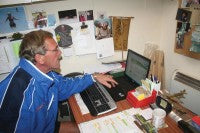 David Bates: Cricket surfaces require a great deal of skill, dedication and, in no small measure, the help of Mother Nature, even though she was not overly helpful in the run-up to this match! Are you given any guidance on how to produce the best test wicket standard?
David Bates: Cricket surfaces require a great deal of skill, dedication and, in no small measure, the help of Mother Nature, even though she was not overly helpful in the run-up to this match! Are you given any guidance on how to produce the best test wicket standard?
Steve Rouse: No, it is entirely left to my knowledge, understanding and experience.
DB: What are you trying to achieve?
SR: I'm looking for a smooth, flat surface with no blemishes which may affect the bounce. Initially, I want a good, dense sward which, over time, is reduced to the playing height. The bounce we try to develop is one where the ball rises to stump height off of a good length of about two to three metres from the popping crease, depending on who's bowling, of course. When the ball impacts on the surface it should not shoot. I simply try to produce consistent bounce and pace. The surface must be completely dry at the commencement of play. Any movement of the ball should be imparted by the bowler.
DB: When do you and your staff start work on the wicket?
SR: To ensure a quality, Test standard wicket, we start immediately the final ball of the previous season is bowled. During the season the lads carry out ongoing maintenance and, any pitches used for the last time, within the season, undergo a full renovation. Therefore, only the last few wickets will need total renovation at the season's end.
 Many grounds, who call upon my advice, tend to leave all repairs until the end of the season. In my opinion, this is a mistake. We repair them as we go.
Many grounds, who call upon my advice, tend to leave all repairs until the end of the season. In my opinion, this is a mistake. We repair them as we go.
DB: What do your renovations consist of?
SR: We soak the wickets first, if necessary several times. Over the next day we prick the surface to encourage greater penetration of moisture. All foot holes are cleared out and filled to surface levels. Once the treatments have been completed, and the surface scarified, we then apply seed using the Blec uni-seeder. It's slow, but very effective. Thousands of holes are produced and the seed sits within the little 'pot plant' holes.
I have good results using Barenbrug seed. I've tried all the others, but their test wicket grass seed mixture suits my soils. To get quick germination and good cover prior to the winter I sow heavily and, if necessary, several overseedings may be made to induce and introduce new strong grasses into my pitches.
Following seeding a light covering of Ongar loam is given. Only when the seeds have germinated and developed do we apply several heavier dressings. We don't smother the young seedlings. We pick our weather then dress accordingly. Luting is vitally important, and brushing and matting also helps.
DB: Many smaller clubs find they have a thatch problem within their squares. How's yours?
SR: No such problem exists here as we constantly control it. However, when I became head groundsman here, the standard of the wickets, at that time, was pretty poor. For example, a game between England and the West Indies was over in just two and a half days. That is not something that either the ECB or the paying public want to see.
 With the help of your good self, we identified two root breaks at differing depths and, by resolving that and experimenting with perennial rye grass mixtures, soon began to see improvements in the wickets.
With the help of your good self, we identified two root breaks at differing depths and, by resolving that and experimenting with perennial rye grass mixtures, soon began to see improvements in the wickets.
DB: What is your fertiliser programme?
SR: We apply autumn/winter fertilisers and careful feeds of nitrogen to reduce the ingress of disease as much as possible. We are very prone to disease with the nature of the environment here at Edgbaston. Over winter, we apply iron in an attempt to manage disease attack. A feed of 4:0:4 + 4%Fe, 2%Mg and EarthMate, a humic acid powder blended with nutrition, is also applied. Fungicide is applied to reduce the risk of disease, particularly over Christmas time.
DB: So, when do you start thinking about pre season activity on the square?
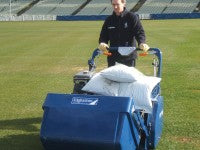 : We never really stop, but we generally start in earnest in February. However, this year, due to the cold winter, we couldn't start until early March. we began by firming the square using the small hand mowers, moving up to our Allett 36". We increase the weight steadily by adding bags of loam to the mower. We do this in every possible direction but always finish each rolling procedure in the line of play.
: We never really stop, but we generally start in earnest in February. However, this year, due to the cold winter, we couldn't start until early March. we began by firming the square using the small hand mowers, moving up to our Allett 36". We increase the weight steadily by adding bags of loam to the mower. We do this in every possible direction but always finish each rolling procedure in the line of play.
DB: When does the heavy roller come out?
SR: In late March, early April. This is when the first county wickets, and practice wickets on the edge of the square, are chosen, bringing them through to playing standard by mid April. One hundred and fifty hours of rolling is not unusual throughout this time frame. The rolling operation is made evenly to the entire square. I usually cover the wickets about two to three weeks prior to them being required for usage.
DB: What else are you doing at this time?
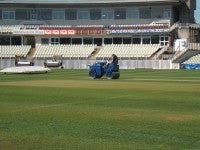 : If any wickets are still thin, we overseed again to thicken the sward. I use a starter feed of 14:0:7+4%Fe, 2%Mg with humates. This has proved to be an excellent stimulator at this time. During the spring it is important for us to brush the square regularly to dissipate the moisture on the leaf of the grasses, and again following the rolling and feeding programme. Although we top the grasses throughout the winter to control the height, mowing now starts in earnest.
: If any wickets are still thin, we overseed again to thicken the sward. I use a starter feed of 14:0:7+4%Fe, 2%Mg with humates. This has proved to be an excellent stimulator at this time. During the spring it is important for us to brush the square regularly to dissipate the moisture on the leaf of the grasses, and again following the rolling and feeding programme. Although we top the grasses throughout the winter to control the height, mowing now starts in earnest.
DB: What is happening to the Test wicket during this period?
SR: All the wickets are set out in accordance with our square plan. The wickets are marked out for the season at ten feet centres. There are twenty-six wickets on the main square, the three main wickets in the centre of the square tend to be used for televised games.
The Test wicket is brand new, having been under reconstruction since 2007. We played a short game on it to ensure it played as we expected.
Basically, throughout the spring our main job is to brush, mow, roll and feed, performing any scarification and overseeding as needed.
 : When do you begin your final preparation of the wicket?
: When do you begin your final preparation of the wicket?
SR: Approximately fourteen days before the Test. We repair any scars and marks caused by the players. At least two wickets are under preparation at any one time, just in case of problems.
This involves brushing. We use two Sisis Lawnman's, one with a brush attachment and the other with the scarification rake attachment. Alternate brushing, scarifying and mowing are performed over a period of a week or so. I also have various hand mowers set up at different height of cut which are used for different purposes, i.e. wicket, cricket square. Cross brushing, scarification and mowing are also key to the removal of grass content prior to the commencement of the match.
DB: When do you know it's ready?
SR: Only experience can determine how much grass is left on a pitch. In dry weather a covering of grass is needed to protect the surface from cracking open. Keeping the surface moist enough to hold may be a real challenge to us due to other county games in and around the time of preparation for the Test match.
 Slow methodical rolling is undertaken each and every day to dry out the wicket for the start of the match.
Slow methodical rolling is undertaken each and every day to dry out the wicket for the start of the match.
On the day of the match we brush, scarify, mow, roll and mark out before handing it over to the umpires. Thereafter, we can clean up bowlers' ends and make good, but only cut, roll and mark out under their watchful eye.
DB: The outfield always looks good at Edgbaston. How do you achieve that?
SR: Rob Franklin, my number two, tends the outfield. He cuts north to south and then east to west to manicure the ground and to steadily develop the sward.
This year we gave it a really slow release fine grade feed of 28:3:15 +2%Mg +65% PolyN supplemented by EarthResponse at 100 litres per hectare, and 25 litres of EarthHiK soil conditioners from Earth-Tec. Steve Loveridge, of Complete Weed Control, carries out the spraying for us.

A further liquid nutritional feed, along with soil conditioners and wetting agents, will take place seven days prior to the match starting.
Hopefully, by this point, the results of our work will be there for all to see. Now it's down to the players to perform on it!
The methods described above will certainly continue while I'm head groundsman. Why change things if they prove successful.
After that we start all over again!
With apologies to Steve for the weather!
Main image © Pitchcare
Working images © David H Bates
All other images courtesy and © of Sky Sports
Contact David H. Bates on 07736 066031 or email at DHBatesservices@aol.com
